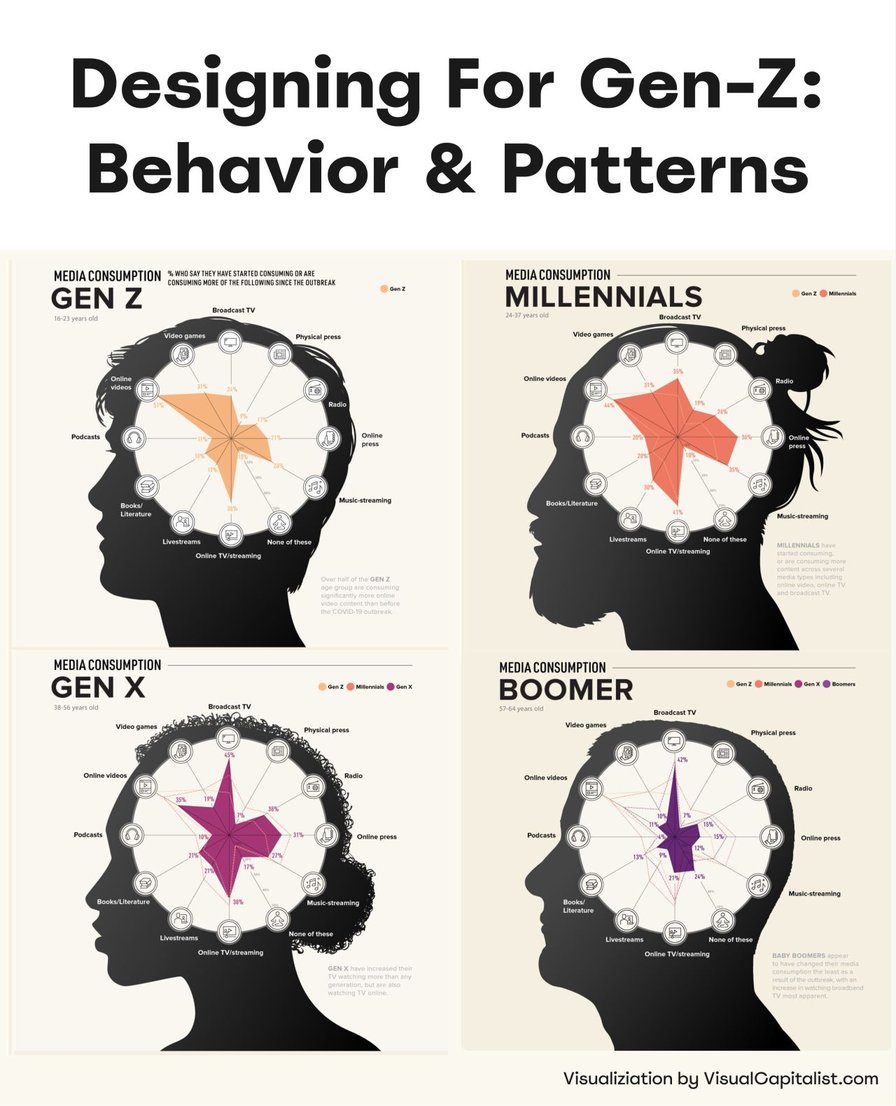Designing For Gen Z

my notes ( ? )
Gen Zs are born roughly between 1995 and early 2010s.
✅ Most diverse generation in terms of race, ethnicity, identity.
✅ With a very broad view of diversity, focused on inclusivity.
✅ Value experiences, principles, social stand over possessions.
🚫 Not homogenous: have diverse perspectives and opinions.
🚫 Not a “passive” generation → caring, proactive, eager to work.
✅ Large parts of Gen-Z aren’t mobile-first, but mobile-only.
✅ To some, the main search engine is YouTube, not Google.
✅ Trust only verified customer reviews, influencers, friends.
✅ Used to follow events live as they unfold → little patience.
✅ Sustainability, reuse, work/life balance are top priorities.
✅ Prefer social login as the fastest authentication method.
✅ Typically ignore or close cookie banners, without consent.
✅ Rely on social proof, honest reviews/photos, authenticity.
✅ Most likely generation to provide a referral to a product.
✅ Typically turn on subtitles for videos by default.
Today, the oldest segments of Gen-Z are in their late 20s, and the youngest are in the middle school. They are often dismissed as a “slow, passive” generation that doesn’t really care about much. But research shows it couldn't be further from the truth.
Unsurprisingly, social media is a huge part of the Gen Z lifestyle. But because they are sceptical of brands by default, they rely on social circles, influencers and peers as main research channels. They might not be great at spotting what’s real and what’s not, but they are highly selective about their sources.
Most design advice on Gen-Z focuses on producing “short form, snackable, bite-sized content”, and it often cites a Microsoft study from 2015 that showed that the average attention span for Gen-Z is around 8 seconds
I would encourage us to do the opposite.
We shouldn’t discount Gen-Z as a generation with poor attention spans and urgent needs for instant gratification. We can tell a damn good story. Captivate and engage. Encourage critical thinking. Provide sources. Make them think. Gen-Z is curious and interested, and they want to be challenged and to succeed.
So support that. Remove clutter and anything that gets in the way. Support intrinsic motivation, not extrinsic motivation. Invest in good content design. Aim for the opposite of perfect. Say what you think and do what you promise. Reflect the real world with real people using real products, however imperfect they are.
In times when there is so much fake, exaggerated, dishonest and AI-generated content, it might be just enough to be perceived as authentic, trustworthy and attention-worthy by highly selective and very demanding Gen Z.
One final note is that unlike previous generations, Gen Z genuinely appreciates feedback and values platforms that actively listen to their opinions AND make changes based on their feedback. So the best thing wen can do, as designers, is to actively involve Gen-Z in the design process.
I keep repeating myself as a broken record, but better accessibility is better for everyone. Many attributes and expectations that we see in Gen-Z can be only beneficial for all other generations. And perhaps for the first time ever, inclusion and accessibility will be perceived as a default expectation, and that’s a great thing.
Sources and useful resources:
Designing for Gen Z, by Designlab
https://lnkd.in/eTZD8EPu
Designing For Gen Z (Case Study), by Michelle Winchester
https://lnkd.in/eagRHMBp
Intrinsic vs. Extrinsic Motivation, by Paula Gomes
https://medium.com/@paulasg/how-to-increase-players-intrinsic-motivation-d00368697d19
Shopping Habits For Gen Z, by Sara Karlovitch, M.P.P.
https://lnkd.in/eTWK4NKa
10 Gen Z Insights To Improve Your CX, by Telus
https://lnkd.in/eCRM_hF9
Millennials vs. Gen Z Expectations, by Zendesk
https://lnkd.in/eJHezHrS
Happy designing, everyone! I hope you'll find it useful.
Here's the source of the visual above: https://www.visualcapitalist.com/media-consumption-covid-19/
Read the Full Post
The above notes were curated from the full post www.linkedin.com/posts/vitalyfriedman_ux-design-activity-7234099285577867265-z4uI?utm_source=share&utm_medium=member_desktop.Related reading
More Stuff I Like
More Stuff tagged user behaviour , design , design patterns , patterns